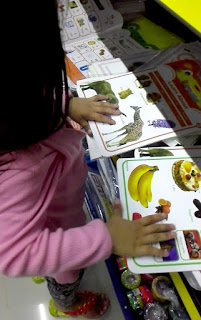Teaching English For Young Learner
VISUAL, REALIA AND MOVEMENT
 |
| Photo by me |
They might view your classes as simply another fun daily activity and that is just fine. Even at this early age, you can encourage them to develop an interest in learning English.
As a teacher we need to know or understanding our student. The young learner have a high curiosity, active and easy to get bored. surely they will have a short attention span to what the teacher explains in front of class, and looking for something interesting to do.
okay, these are the ideas for teaching young learner.
" Suplement activities with Visual, Realia and movement "
Visual
Visual is describes something that is seen. Visual aids can be defined in two ways: as a picture or a diagram you
show learners to help their understanding, or in a broader sense as
anything you show learners in a classroom to do this.
Example :
The class is learning vocabulary to name parts of the face and the teacher uses photographs of people as a visual aid.
In the classroom Teachers can use pictures, video, symbols, gestures and facial expressions as visual aids.
Realia
Example :
The class is learning vocabulary to name parts of the face and the teacher uses photographs of people as a visual aid.
In the classroom Teachers can use pictures, video, symbols, gestures and facial expressions as visual aids.
Realia
In EFL terms refers to any real objects we use in the classroom to bring the class to life. The main advantage of using real objects into the classroom is to make
the learning experience more memorable for the learner.
To give a couple of simple examples, if you are going to teach vocabulary of fruit and vegetables it can be much more affective for students if they can touch, smell and see the objects at the same time as hearing the new word. This would appeal to a wider range of learner styles than a simple flashcard picture of the piece of fruit or vegetable.
To give a couple of simple examples, if you are going to teach vocabulary of fruit and vegetables it can be much more affective for students if they can touch, smell and see the objects at the same time as hearing the new word. This would appeal to a wider range of learner styles than a simple flashcard picture of the piece of fruit or vegetable.
Movement
As stated before, young learners have short attention spans. For young students, from ages 5 to10 especially, it is a good idea to move quickly from activity to activity. Do not spend more than 10 or 15 minutes on any one activity because children tend to become bored easily.
As children get older, their ability to concentrate for longer periods of time increases. So for students ages 5–7, you should try to keep activities between 5 and 10 minutes long. Students ages 8–10 can handle activities that are 10 to 15 minutes long. It is always possible to revisit an activity later in class or in the next class. When teachers mix up the pace of the class and the types of activities used, students will be more likely to stay focused on the lesson, thereby increasing the amount of language learning in class
Alhamdulillah. ngeblog juga.
BalasHapusAlhamdulillah, perdana 😂😂
Hapus